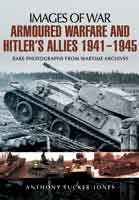This fascinating book in the Images of describes the decidedly mixed fortunes of the states siding, willingly or otherwise, with the Nazis to fight against Russia.
We have a chapter each on Hitler’s friends fighting against the Soviet Union. Sometimes the friendships were forged out of expediency rather than affection, but the end result for these regimes were generally the same, disaster.
The exception is fascist Spain where the leadership were wise to keep the country out of the wider war and secured their dominance for decades to come.
Of course it is fair to say that for Czechoslovakia disaster had already happened. The people were living it. The chapter devoted to the Czechs concentrates on how the Nazis appropriated the superb armaments industry of the recently dismembered state to supply tanks and other weapons to fuel their ambitions. The independent Slovaks were more willing to fight alongside the Germans and sent two divisions to Russia.
It is interesting to see how local rivalries between the Hungarians and Romanians in particular had a hand in prodding the two states into the Nazi embrace. Both were monarchies with a hard man calling the shots behind a vulnerable thrown and territorial ambitions were always at the centre of their plans. As we saw from the book I reviewed recently on air battles between the Hungarians and Slovaks, wars within wars were never off the agenda and land grabs had been taking place. But the uniting influence in all of this was the perception of the Slav menace from the east. The Germans skillfully exploited the fear of this to draw in their client states and lead them to destruction.
You can almost see how the leaders of these countries made their decisions. We have the gift of hindsight to blind our perceptions but we have to put ourselves in their shoes to get an accurate assessment of how things seemed to be going. The chances of mighty Germany losing against the Russians would have appeared remote and the potential for glory and redrawn borders, let alone a sense of permanent security under the Reich’s umbrella presented a wonderful opportunity. Victory would have cemented the power of the fascist regimes for a considerable time much as it proved to do in Spain.
For the Finns alliance with the Germans was more of an expedience than anything else. During the first war Plucky Finland enjoyed the admiration if not any serious tangible assistance from the western democracies. But with the Continuation War, Finland was tied to Germany and this was a wholly different ball game.
Mussolini’s Italy sent an army to the Russian front. Lacking adequate armour and artillery it must have been a miserable experience, to say the least, for the Italian infantrymen. Once again the issues of prestige and honour were paramount but the result was the same.
The finale to the story has some of countries changing sides and fighting among themselves. The Germans had the unwelcome experience of the Bulgarians using Nazi supplied panzers against them. None of this would help King Boris or save his country from Soviet dominance.
As usual with these books the archive photography is central to credibility and here we have a genuinely excellent spread of images showing all the participants. There is something about the images of so many hopelessly inadequate tanks pitted against the might of the Red Army or used in policing roles that highlight the iniquities of the Axis alliance. The cynicism of Hitler, controlling the flow of supplies of tanks to his client states is so apparent. But it is difficult to see what more the Nazis might have done given their increasing commitments.
This book has much to offer. The images are excellent and I found it to be an informative and easy read. There is quite a bit here for model makers and anyone who has a liking for the sort of armour used in the early years of the war. French built tanks appear to turn up in all the wrong places at the wrong time, while Italian and other home built kit fair little better. There is a kind of tragic naivety to it all that really impresses on us how hopeless things proved to be for the states embroiled in supporting Hitler’s ambitions. Good stuff.
Reviewed by Mark Barnes for War History Online
ARMOURED WARFARE AND HITLER’S ALLIES 1941-1945
By Anthony Tucker-Jones
Pen & Sword Military
ISBN: 978 1 78159 258 8
